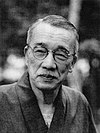List of Prime Ministers of Akashi
This is a list of Prime Ministers of Akashi in modern times.
List of Prime Ministers
| Portrait | Name (Birth–Death) |
Term of office | Election | Political party | Government | ||
|---|---|---|---|---|---|---|---|

|
Yurika Ehara 友里花 江原 (1905–1989) |
15 January 1940 |
1 September 1970 |
Constituent Assembly 1942 1946 1950 1954 1958 1962 1966 |
National Union | NU majority Supported by: NCP, AP, SP | |
| National unity government NU–NCP–AP–SP–SCP–CP–NDP–RP | |||||||
| Yurikara came to power by winning the Akashian Civil War. A key figure of modern Akashian history, she served as President and Prime Minister simultaneously for 30 years. Her distinctive political course was based on civic nationalism, state-led development, and national "grandeur". Her NU won 7 elections in a row, and she relied on the centrist bloc of the NCP and AP, occasionally seeking support from the leftist SP.
She presided over a lengthy economic boom, widespread prosperity, the development of Akashian popular culture, and various socially liberal reform projects. The length of her tenure ultimately bred frustration that erupted in mass protests and strikes in 1968. She formed a national unity government to resolve the crisis, taking a restrained approach and introducing political reforms to "open up the system". She stepped down as Prime Minister in 1970, but remained President for another decade. | |||||||

|
Masaki Ōshiro 将樹 大城 (1899–1987) |
1 September 1970 |
8 May 1972 |
1970 | National Union | NU–SP–NCP coalition Supported by: SCP, AP | |
| Succeeding Yurikara as Prime Minister, Masaki led the NU to its last plurality, falling one seat short a majority in 1970. He formed a coalition with the NCP and SP, underlining the NU's drift to the centre-left.
Regarded as a vacillating figure, Masaki struggled with the onset of the "siege economy", torn between mainstream economics and the SP's push for more leftist policies. He failed to prevent splits from emerging in the NU and lost a budget vote, prompting a snap election in April 1972 that felled the NU as a major party. | |||||||

|
Tarō Yukimura 太郎 行村 (1904–1998) |
8 May 1972 |
15 May 1974 |
1972 | Socialist Party | SP–NCP–NU–AP coalition Supported by: CP, SCP | |
| The first socialist Prime Minister. Tarō formed a coalition with the NCP, NU, and AP, and leaned heavily on outside support from the CP and SCP.
His government broke up the large companies created by Yurikara's national champions policy, introduced legislation to strengthen trade unions and workplace democracy, and pushed for greater planning and cooperativisation of the economy. Although beset by weak growth and high inflation, the government managed to keep unemployment low and hold the line on social expenditures and public services, allowing inequality and poverty to further decline. In domestic politics, he continued constitutional reforms that strengthened local government and increased the Prime Minister and National Assembly's power at the expense of the President. Growing discontent with his tenuous leadership and poor results in the 1973 prefectural elections convinced him to resign before the upcoming general elections. | |||||||

|
Kasumi Kuroki 霞 黒木 (1924–2015) |
15 May 1974 |
9 October 1977 |
— 1974 |
Socialist Party | SP–NCP–NU–AP coalition Supported by: CP, SCP, JP | |
| A popular figure in the previous government, Kasuko took office before the 1974 general election, leading the SP to win more seats. She continued the left coalition and sought a rapprochement with the JP, which had split from the SP in frustration with Tarō's communist leanings.
Kasuko's government introduced the Anti-Hoarding Law, which capped annual incomes and used high marginal taxes on the wealthy to nationalise and "recirculate" idle capital. She worked closely with other Common Sphere governments to prevent capital flight, and to strengthen the Common Monetary System. She abandoned annual budgets and instead relied on mini-budgets (小予算 shōyosan, "little budget") to guide the economy. Her government abolished the national health insurance and converted Akashian healthcare to a single-payer system. Confronted with a currency crisis in late 1977, she introduced the "black budget" (黒予算 kuro yosan): excise taxes were hiked to reduce consumption, surcharges were imposed to reduce imports, excess profits tax was levied on the largest companies, some rationing was introduced, and the ryō was readjusted within the Common Monetary System. She responsibility for the drastic response to the crisis, and resigned before the National Assembly could hold a no-confidence vote. | |||||||

|
Naoko Nemoto 七保子 根本 (1938–) |
9 October 1977 |
1 December 1977 |
— | National Cooperative Party | Interim | |
| The finance minister throughout the 1970s, Naoko served as interim Prime Minister for several months until the selection of a new SP leader. She maintained the measures of the "black budget" and used them to strengthen the cooperative sector. | |||||||

|
Yumiko Nagatsuki 優美子 長月 (1926–) |
1 December 1977 |
10 January 1979 |
— 1978 |
Socialist Party | SP–NCP–JP–NU–AP coalition Supported by: CP, SCP, GP | |
| Yuna led a "reorganised" left coalition, formally including the JP and courting support from the new GP.
Her government made a slight retreat from the "black budget", but largely maintained the restrictions on capital and foreign exchange. She negotiated with the Sōhyō to pass tax cuts in exchange for wage restraint. When the accord was weakened by continued wildcat strikes, she implemented an incomes policy to control wages and prices. The incomes policy managed to reduce inflation somewhat, at the cost of destabilising Akashi's balance of payments. Unusually, Yuna temporarily stepped down as Prime Minister in favour of AP leader Hikaru Katayama in January 1979, before resuming her post. | |||||||

|
Hikaru Katayama ひかる 片山 (1934–) |
10 January 1979 |
28 February 1979 |
— | Agrarian Party | SP–NCP–JP–NU–AP coalition Supported by: CP, SCP, GP | |
| The incumbent agriculture minister, Hikaru temporarily became Prime Minister to secure the passage of a land reform bill through the National Assembly. It was hoped she could obtain support from the centre-right parties. When the bill succeeded, she resigned and resumed her post in the cabinet. | |||||||

|
Yumiko Nagatsuki 優美子 長月 (1926–) |
28 February 1979 |
1 September 1980 |
— | Socialist Party | SP–NCP–GP–NU–AP coalition Supported by: CP, SCP, JP | |
| Returning as Prime Minister, Yuna reshuffled the government. The GP joined the cabinet for the first time, while the JP exited but continued to provide outside support.
Facing a depletion of foreign exchange reserves, the government turned to heterodox monetary policies to stimulate the economy. Scrips were issued to provide additional liquidity without weakening the ryō. The working week was reduced to three days and working hours shortened to conserve electricity. Cabinet relations were fraught: the SP's attempts to avert deindustrialisation conflicted with the GP's environmentalism. The government negotiated an economic aid agreement with Quenmin, but the National Assembly rejected it in 1980. Yuna requested a snap election for June, which the SP lost badly. She insisted on resigning when the new legislature was inaugurated rather than continuing as caretaker. | |||||||

|
Toshirō Kuno 俊郎 久野 (1935–) |
1 September 1980 |
1 December 1980 |
1980 | Justice Party | Interim | |
| After the 1980 snap election returned a badly hung parliament, President Masako Nakai initially asked JP leader Toshirō to form a government. He failed to secure confidence for a left–centre government or a centre-left government tolerated by the centre-right, and resigned. | |||||||

|
Mutsuhito Ōe 睦仁 大江 (1905–1995) |
1 December 1980 |
16 February 1981 |
— | National Union | Interim | |
| Mutsuhito attempted to form a grand coalition government, to include the leftist SP and JP, a centrist-leaning NU, and the centre-right NDP, RP, and UA. His second option was a minority NU government tolerated by the centre-left and centre-right. Neither option commanded legislative confidence, so he resigned. | |||||||

|
Þiudawulþus 𐌸𐌹𐌿𐌳𐌰𐍅𐌿𐌻𐌸𐌿𐍃 (1929–2009) |
16 February 1981 |
1 September 1982 |
— | Independent | Interim | |
| A long-serving independent MNA, Þiudawulþus was designated to form an interim government, becoming the first Goth Prime Minister. He formed a "technical government" composed of civil society figures and academics, with a mandate to keep government and public services functioning until the National Assembly could agree on a definite Prime Minister. | |||||||

|
Ran Tsukuda 蘭 佃 (1949–) |
1 September 1982 |
25 December 1989 |
1982 1986 |
Conservative National Party | CNP–NDP–RP–UA–LP coalition Supported by: NCP, NU | |
| CNP minority Supported by: NDP, RP, UA, LP, NCP | |||||||
| The leader of the CNP's "soft" (緩い yurui) faction, Ran triumphed in the "kibi-yuru war". She and her allies seized control of the CNP and worked to transform it into a progressive conservative party, purging hardliners and recruiting sanyoi candidates.
Ran won the 1982 election promising pragmatic governance, economic renewal, and constitutional reform. She formed the first centre-right coalition since the civil war, and sought external backing from the NCP and NU. Her government succeeded in reviving the economy while largely preserving the egalitarian legacy of the "siege economy". Non-performing state assets were restructured and cooperativised, the ryō was stabilised, inflation reduced, and national retraining programs introduced with Sōhyō cooperation to maintain full employment. Ran won broad popularity and respect for her consensual governance and negotiating talent. Her tenure saw renewed industrial peace after the turbulence of the 1970s, administrative reforms to improve government transparency and accountability, and the adoption of the Constitution of 1984. She won re-election in the "blue wave" of 1986, when the CNP finished one seat short a majority alone, and was acclaimed for her decisive response to the 1987 stock market crash. In contrast to her success in government, Ran's faction had a more tenuous hold on the party. Akashi's rich class grew hostile to her anti-big business government, and linked with her hardliner enemies and others in the neoliberal conspiracy. While on vacation abroad, she was deposed by an internal party coup. | |||||||

|
Ichirō Kondō 一郎 近藤 (1932–1994) |
25 December 1989 |
1 April 1990 |
— | Conservative National Party | CNP minority Supported by: FL, ARP | |
| The leader of the CNP's "hard" (厳しい kibishii) faction, Ichikon took office during the neoliberal conspiracy. He launched an internal purge to rid the CNP of the yurui faction, and tried to push through a neoliberal program of tax cuts, privatisation, deregulation, and weakening trade unions.
Ichikon's sudden rise to power caused chaos in the CNP ranks and revolted the public. Mass protests and a general strike erupted against his program, the largest since 1968. He sought support from the right-wing FL and ARP, and narrowly passed his program through parliamentary chicanery, only for it to be vetoed by President Emi Hanamura and decisively rejected by voters in a referendum. Having lost control of the party and provoked mass unrest, Ichikon lost a confidence vote and his party was devastated by the general election. He was prosecuted for his role in the neoliberal conspiracy, and died in prison. | |||||||

|
Shinobu Furukawa 忍 古川 (1928–2014) |
1 April 1990 |
3 January 2000 |
1990 1994 1998 |
Communist Party | CP–SP–GP–SCP–JP coalition Supported by: NCP, NU, NFP | |
| The first communist Prime Minister. Shinobu ran an aggressive campaign condemning the neoliberal conspiracy, and proclaimed, "The nineties will be communist!". Capturing the moment, the CP unexpectedly benefited the most from the "red wave" of 1990, winning a plurality. She formed a left coalition government, supported by the NCP, NU, and NFP.
Known as "Iron Shinobu" for her tough, straight-talking demeanour, she presided over the most radical left course since the 1970s. Her government broke up remaining large companies, expanded the cooperative and public sector, hiked taxes to destroy wealth concentration, reformed labour law to universalise workers' self-management and co-determination, and expanded planning through the Hermes Programme. Further decentralisation and municipalisation took place. Shinobu aggressively prosecuted and punished the participants in the neoliberal conspiracy, which at times discomfited public opinion. Her forceful governance style gradually became a liability. While her left coalition won re-election in 1994, it lost ground in the hung parliament produced in 1998. Shinobu attempted to remain in office and reach out to the centre, but her hold on power was now weakened. She lost a no confidence vote in December 1999 and the ensuing snap election. | |||||||

|
Ran Tsukuda 蘭 佃 (1949–) |
3 January 2000 |
1 September 2002 |
1999 | Moderate People's Party | MPP–URP–LP–NCP coalition Supported by: NFP, FP | |
| Following the neoliberal conspiracy, Ran and her faction left the CNP and formed their own party. Winning the 1999 election, she formed a centre-right coalition that included the NCP, and relied on support from the new centre parties NFP and FP.
Ran served two further years as Prime Minister, preserving Shinobu's legacy while moderating her policies. She consolidated the MPP on the centre-right and promoted a new generation of sanyoi politicians. Her most notable achievement was consolidating various welfare programs into Universal Assistance, a precursor to basic income. | |||||||

|
Anna Carbone 杏奈 カーボネ (1965–) |
1 September 2002 |
1 September 2010 |
2002 2006 |
Moderate People's Party | MPP–URP–LP coalition Supported by: NCP | |
| The first minority Prime Minister. Anna succeeded Ran as party leader, and led the centre-right coalition to re-election in 2002. The NCP exited government but continued to provide support.
Anna's government carried out progressive social reforms, strengthened environmental protection, aided the country's small banks and consumer finance sector, and continued expansion of cooperatives and public services. It maintained the redistributive framework created by Shinobu, and adopted monetary policies to reduce inflation. Anna's low-key style of governance left her often overshadowed by her flamboyant and boisterous finance minister, Liana Ferrari. Liana sought to use her leadership of the URP to push the government to the left, and was a key figure in the "blue wave" of 2006, capitalising on SP disunity to lead the URP to a second-place finish. The government lost the next election. | |||||||

|
Kōko Kaga 香子 加賀 (1980–) |
1 September 2010 |
Incumbent | 2010 2014 2018 |
Socialist Party | SP majority Supported by: CP, GP, SCP, JP, NCP, NU, NFP, FP | |
| SP–GP–NCP–NU coalition Supported by: CP, SCP, JP, NFP, FP | |||||||
| The youngest Prime Minister. Kōko won the party leadership shortly before the 2010 election, and caused a dramatic increase in SP's popularity, an effect nicknamed "Kōkomania". The 2010 election became a "red wave", with the SP winning the first single-party majority since 1970. She formed a single-party government, seeking support from the left and centre.
Kōko's government has pursued a program of "21st century socialism", with flagship policies including the conversion of the welfare system to a basic income–negative income tax model, growing the cooperative sector, shifting the economy towards decentralised planning, and increasing the public's role in self-governance and economic planning. The SP lost its majority in 2014, prompting Kōko to form a coalition with the GP, NCP, and NU, while retaining outside support from the left and centre. The coalition won re-election in 2018. | |||||||